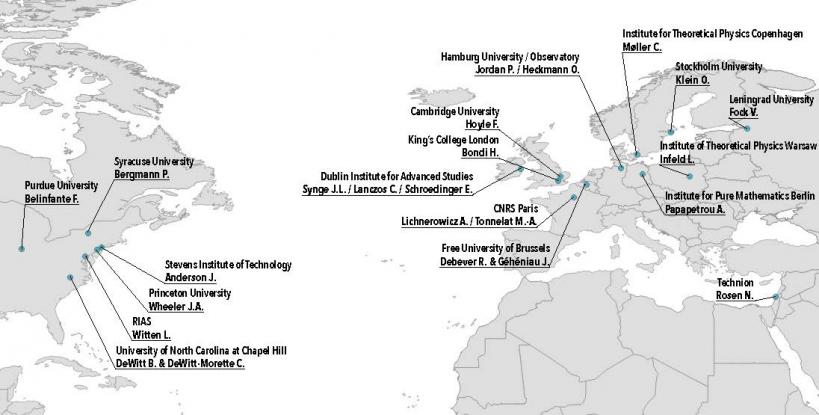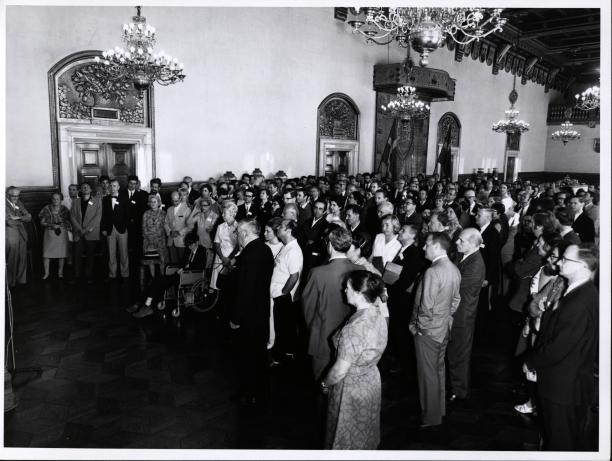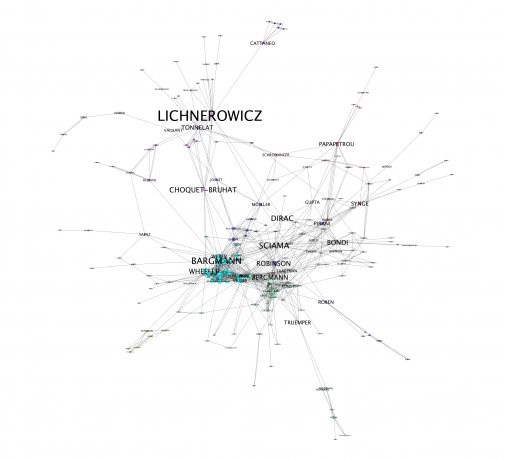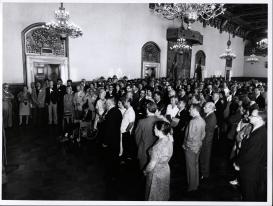The complex development of general relativity presents intriguing challenges for historians of science. After an initial burst of excitement about its extraordinary implications, the theory underwent a thirty-year period of stagnation, during which only a few specialists—mostly mathematicians—worked on it. In the aftermath of World War II, however, general relativity gradually re-entered the mainstream of physics, attracting an increasing number of practitioners and becoming the basis for the current standard theory of gravitation and cosmology—a process that Clifford Will coined the “renaissance” of general relativity.

Map of the major research centers working on topics related to general relativity in the United States and Europe in 1955. Image: Florian Kräutli and Roberto Lalli.
Therefore, to investigate the transformation of general relativity from a marginal theory to a building block of modern physics, a project was initiated in 2014 involving scholars from different institutions and different fields of expertise. An integrated historiographical framework (Blum, Lalli, Renn) has already been developed in which this historical process is interpreted as resulting from the deep interconnection of epistemic and social factors. Our main claim is that in the post-WWII era Einstein’s theory of gravitation became a field of study in its own right, whereas earlier it had only served as a theoretical framework related to different and dispersed research agendas. This general framework—presented in various articles and conferences—is intended as a guide to frame ongoing research on specific aspects and case studies of this complex process. In December 2015 the scholars involved in the project were joined by a number of eminent experts on general relativity and its history to discuss the renaissance of general relativity during the historical sessions of the large conference A Century of General Relativity, organized jointly with the Albert Einstein Institute (Blum, Lalli, Renn). Furthermore, the topic was chosen as the focus of a special issue of the European Physical Journal H entitled “The Renaissance of Einstein’s Theory of Gravitation” (Blum, Giulini, Lalli, Renn), where various of the more physical aspects of the renaissance process were tackled from a variety of perspectives: the role of research on the quantization of gravitational theory through the analysis of a previously unpublished report of a meeting held in Copenhagen in 1957 (Blum, Hartz); the emergence of experimental research on gravitational physics initiated by Robert Dicke’s group in Princeton in the late 1950s (Peebles); a personal recollection of Joseph Weber’s pioneering role in sparking experimental research on gravitational waves (Trimble); the role of the discovery of binary pulsars in the developments of the theoretical controversy on gravitational waves emission (Kennefick); and, finally, the evolution of theoretical analysis on stellar collapse in the pre-WWII period, which led, after the discovery of quasars, to the emergence of a new scientific field: relativistic astrophysics (Bonolis).

Photo of the reception at the GR6 conference taken by the firm Atelier Bache at the Town Hall (Rådhuset), Copenhagen, 6 July 1971. Source: NORDITA Collection, Niels Bohr Archive.
The social dimension of the formation of the field of “General Relativity and Gravitation” is being investigated employing the concepts and tools of network theory (Lalli, Wintergrün). By mapping the network of collaborations in the research fields related to general relativity from 1930 to the early 1970s, the dramatic changes in the connectivity of this network in the post-WWII period are shown. The topological transitions of the network of collaboration provide an unambiguous method to define the historical process of the renaissance of general relativity as well as its periodization. The network analysis also enables the definition of some specific features of the process, which otherwise would not be understandable, such as the role of specific actors in the dynamics of knowledge production in general relativity in connecting different disciplines and research agendas. This research shows in which specific ways the phenomenon of the “postdoc cascade” increased the connectivity between the different research groups and, therefore, different research agendas, allowing for the emergence of a common field pursued by a network of practitioners with a shared baggage of tools and research questions. In addition, a study of the activities of community building and institutionalization in the GRG field in the international arena between the 1950s and the 1970s has been completed (Lalli). The book shows how intertwined the epistemic, cultural, social, and political aspects were in such an attempt to build an international community of “relativists” during the Cold War. It emerges that features specific to the field of general relativity first favored such an international exchange in the 1950s and then allowed scholars to overcome a number of tensions of a different nature, eventually leading to the formation of the International Society on General Relativity and Gravitation, which had a quite peculiar structure in the landscape of international scientific organizations at that time.

Network of collaboration of scientists working on General Relativity and Gravitation in 1962. Image: Roberto Lalli, Dirk Wintergrün.
A complementary approach focuses on one central actor of the renaissance, John Archibald Wheeler, who was the leader of one of the major centers of general relativity in the 1950s and 1960s at Princeton; but even more importantly, his personal career is a micro-image of the renaissance at large, as he switched from mainstream nuclear physics to research in general relativity in the early 1950s. Through an in-depth study of his detailed notebooks, we reconstruct this surprising conversion and compare this prominent and well-documented individual case with the social and epistemic factors identified in the overall historiographical framework (Blum, Brill).
Focusing on a specific research strand in the renaissance, instead of a specific individual, the project (Blum, Lalli, Renn) has now also begun to pursue a detailed study of the history of gravitational wave research, in particular pursuing the question of the relation between theory (abstract existence proofs), phenomenology (source simulation), and experiment (gravitational wave detection) in the development that ultimately led to the first detection of gravitational waves in September 2015.
Most research results of the project have been published in the special issue of European Physical Journal H entitled "The Renaissance of Einstein’s Theory of Gravitation" in 2017 and the volume of the Einstein Studies series entitled The Renaissance of General Relativity in Context published in 2020.

